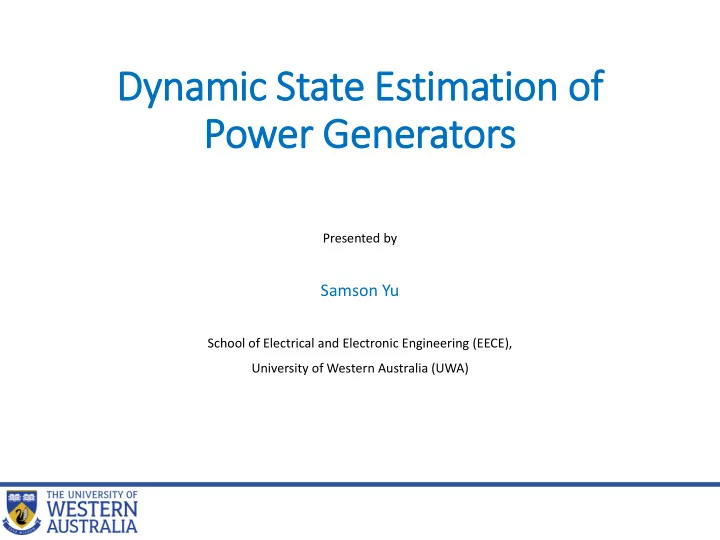

Dynamic State Estimation of Power Generators Presented by Samson Yu School of Electrical and Electronic Engineering (EECE), University of Western Australia (UWA)
0. . Motivations Future grids: “ A seamless, cost-effective electricity system, from generation to end- use, capable of meeting all clean energy demands and capacity requirements” • Societal, economic and environmental.
0. . Motivations Future grids: 1. Scale-up of clean energy (renewables, natural gas, nuclear, fuel cells). Worldwide : invested AUD $350 billion in clean energy 2015, higher than in fossil fuel power plants. DO GOOD and DO WELL. AU : invested AUD $4.3 billion in clean energy 2016. AU RET : 23.5 % of AU’s electricity generated by clean energy by year 2020. Year 2015, 14.7%.
0. . Motivations Future grids: 2. Consumer participation and choice (distributed generation, electric vehicle, etc.). 3. Holistic design solutions (AC-DC transmission and distribution solutions, microgrids, and centralized-decentralized control). 4. Two-way flows of energy and information (Internet Of Thing) 5. Reliability and security (cyber)
0. . Motivations Questions: 1. What are “dynamic states” of power generators? 2. Why do we want to estimate the dynamic states? 3. How can we perform the dynamic state estimation? 4. How can the estimated dynamic states be used?
1. . Dynamic states of f power generators Faster Dynamics Slower Dynamics (Transmission and distribution (All the generators) network with all electrical loads) 𝑦 = 𝑔(𝑦, 𝑣) 0 = (𝑦, 𝑣) • We have a Differential Algebraic Equation (DAE) formulation of a power system. 𝑦 = 𝑔 𝑦, 𝑣 , 0 = 𝑦, 𝑣 .
1. . Dynamic states of f power generators Examples: 1. Rotating power generators I. Synchronous generators II. Asynchronous generators 2. Stationary power generators I. Fuel cells II. Solar PVs III. Nuclear power
1. . Dynamic states of f power generators Synchronous generator
1. . Dynamic states of f power generators Asynchronous generator
1. . Dynamic states of f power generators Fuel cells (e.g., SOFC)
2. . Estimating the dynamic states — Reason Reason 1 — Hard to directly measure. Reason 2 — Some states we want to control, and we need to know them before we can control them. (e.g., gas partial pressure of fuel cells). S. Yu, T. Fernando, Tat Kei Chau and H. H.-C. Iu, “Voltage control strategies for solid oxide fuel cell energy system connected to complex power grids using dynamic state estimation and STATCOM,” IEEE Transactions on Power Systems , DOI: 10.1109/TPWRS.2016.2615075. 04-Oct-2016 Reason 3 — More information may help us design a more effective controller. (e.g., in DFIG knowledge of flux helps with rotor current regulation). S. Yu, T. Fernando, and H. H.-C. Iu, “Dynamic State Estimation Based Control strategy for DFIG wind turbine connected to complex power systems,” IEEE Transactions on Power Systems , vol.32, no. 2, p.p. 1272-1281.
3. . Estimating the dynamic states — How • Internal dynamic states are hard to acquire directly — use the knowns to estimate the unknowns . 𝑦 = 𝑔 𝑦, 𝑣 , 𝑦 = Υ 𝑦, 𝜗 , 0 = 𝑦, 𝑣 , 𝜂 = Ψ 𝑦, 𝜗 , where 𝜗 is measurable input vector and 𝜂 is measureable output vector. • In a power system, voltages, currents and their phase angles are measureable signals, and can be measured by PMUs.
3. . Estimating the dynamic states — How • Use different mathematical methods to perform dynamic state estimation. So far, we have developed several algorithms: • State and Functional Observers to acquire internal dynamic states of synchronous generators. • Extended Kalman Filter for synchronous, asynchronous and stationary power generators. • Unscented Kalman Filter for synchronous, asynchronous and stationary power generators. • Particle Filter for synchronous, asynchronous and stationary power generators. ISSUES: Model validation, model discretization, probabilistic model, PMU measurement noises, transmission time delays, etc.
4. . Estimating the dynamic states — Use The estimated dynamic states of power generators provide more information of the operating conditions, with which we could develop better control strategies to achieve a more favorable control performance. 1. FO-based LFC approach Control Signal IEEE Transactions on Power Systems System
4. . Estimating the dynamic states — Use 1. FO-based LFC scheme Disturbances: Case 1: An increase in load demands on busbar 1, 12, 24. Case 2: An decrease in load demands on busbar 7, 21,24. Schematic of the IEEE standard (New England) 39-bus test system studied
4. . Estimating the dynamic states — Use 1. FO-based LFC scheme Important simulation results
4. . Estimating the dynamic states — Use 2. DSE-based DFIG control strategy IEEE Transactions on Power Systems IEEE Transactions on Power Systems
4. . Estimating the dynamic states — Use 2. DSE-based DFIG control scheme Disturbance (fault): Transmission line between bus 21 and 22 is disconnected. Schematic of the IEEE standard (New England) 39- bus test system integrated with wind turbine power generation system
4. . Estimating the dynamic states — Use 2. DSE-based DFIG control scheme Simulation results of DSE Simulation results of DSE-based control
4. . Estimating the dynamic states — Use 3. DSE-based control strategies for solid oxide fuel cell power plant connected to a complex power grid. 4. DSE-based sliding mode control strategies for wind turbine system. 5. DSE-based sliding mode control strategies for traditional power generators, regulating busbar frequencies and voltage magnitudes. 6. DSE-based frequency restoration strategy for solar PV farm connected to power grids. … See our official website for detailed information on our publications. pace.ee.uwa.edu.au
We are pacing towards a clean energy future !
Recommend
More recommend